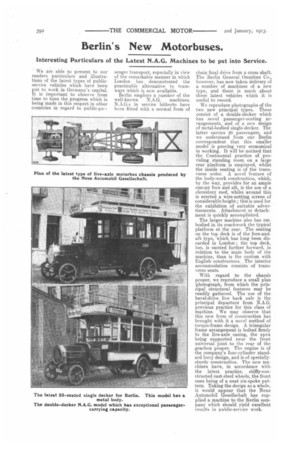Berlin' s New Motorbuses.
Page 14

If you've noticed an error in this article please click here to report it so we can fix it.
Interesting Particulars of the Latest N.A.G. Machines to be put into Service.
We are able to present to our readers particulars and illustrations of the latest types of publicservice vehicles which have been put to work in Germany's capital. It is important to observe from time to time the progress which is being made in this respect in other countries in regard to public-pa:-;
senger transport, especially in view of the remarkable manner in which London has demonstrated the practicable alternative to tramways which is now available.
Berlin employs a number of the well-known N.A.G. machines. N,A.G.s in service hitherto have been fitted with a normal form of chain final drive from a. cross shaft. The Berlin General Omnibus Co., however, has now taken delivery of a number of machines of a new type, and there is much about these latest vehicles which it is useful to record.
We reproduce photographs of the two new principal types. These consist of a double-decker which has novel passenger-seating arrangements, and of a new design of metal-bodied single-decker. The latter carries 23 passengers, and we understand from our Berlin correspondent that this smaller model is proving very economical in working. It will be noticed that the Continental practice of pro viding standing room on a large rear platform is employed, whilst the inside seating is of the trans verse order. A novel feature of the body-work construction, which, by the way, provides for an ample canopy fore and aft, is the use of a clerestory roof, whilst around this is erected a wire-netting Screen of considerable height ; this is used for the exhibition of suitable advertisements. Attachment or detachment is quickly accomplished.
The larger machine also has embodied in its coachwork the typical platform at the rear. The seating on the top deck is of the fore-andaft type, which has long been dis carded_ in London ; the top deck, too, is carried further forward, in relation to the main body of the machine, than is the custom with English constructors. . The interior accommodation consists of transverse seats.
With regard to the chassis proper, we reproduce a small plan photograph, from which the prin cipal structural features may be readily gathered. The use of the bevel-drive live back axle is the principal departure from N.A.G. previous practice for this class of machine. We may observe that this new form of construction has brought with it a novel method of torque-frame design. A triangular frame arrangement is bolted, firmly to the live-axle casing, the apex being supported near the front universal joint to the rear of the gearbox proper. The engine is of the company's four-cylinder stand ard lorry design, and is of speciallysturdy construction. The new ma chines have, in accordance with the latest practice, stiffly-constructed cast-steel wheels, the front ones being of a neat six-spoke pat tern. Taking the design as a whole, it would appear that the Neue .Automobil Gesellschaft has supplied a machine to the Berlin company which should yield excellent results in public-service work.






















